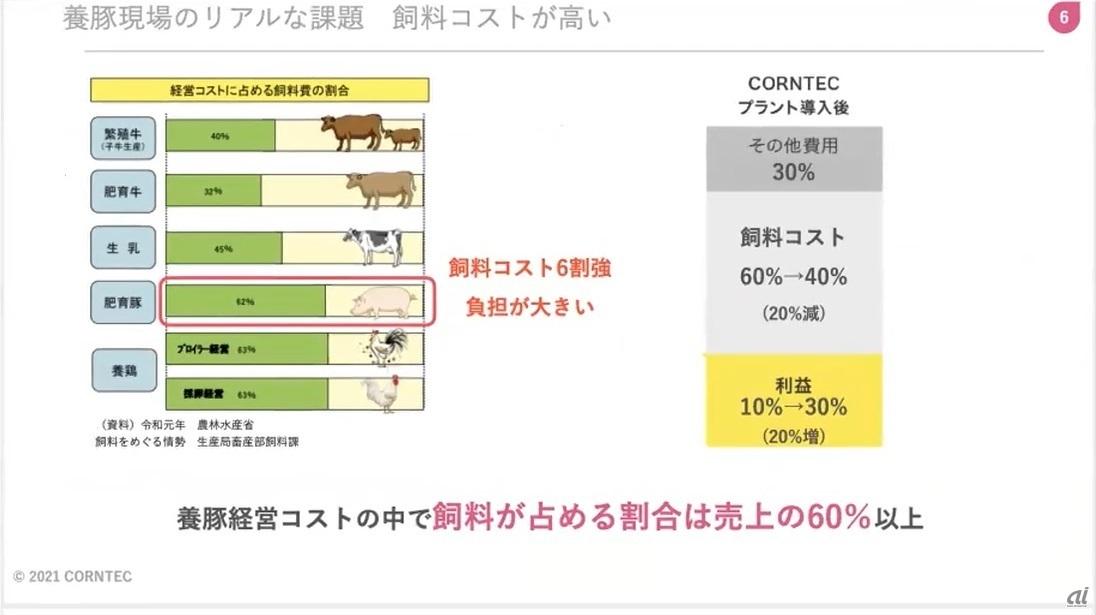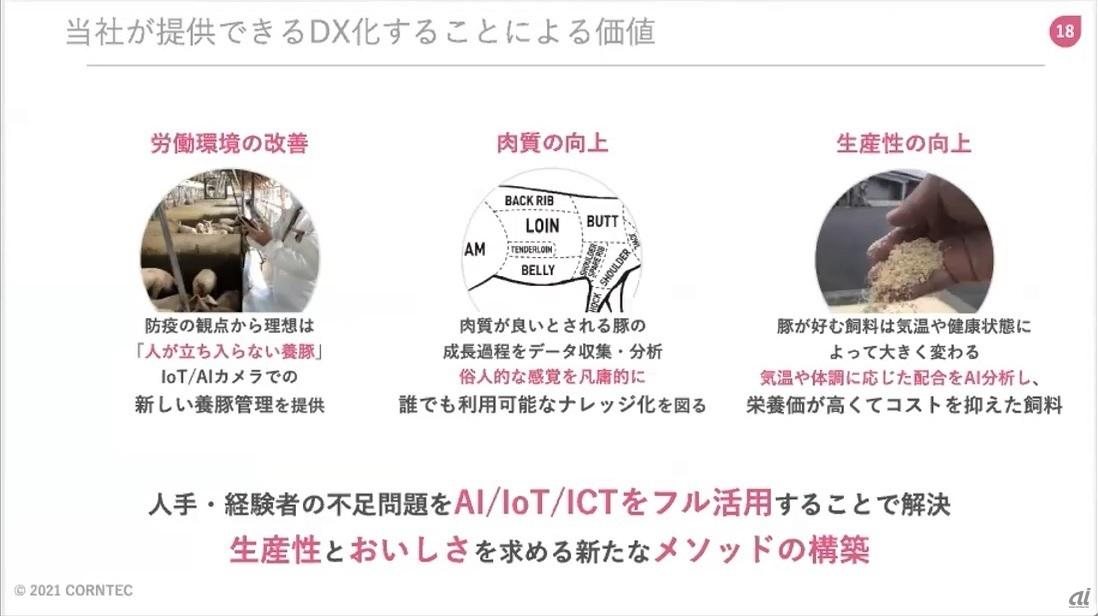Change pig farming with an AI camera--Corntech's goal for livestock DX in the world
At the "CNET Japan FoodTech Festival 2021" held online from October 25th to 29th, Corntech, which develops a pig farming plant introduction and consulting business in Kumamoto City, will appear.
While promoting the industrialization of the analog livestock industry, the company has developed its own IoT / AI livestock monitoring service "PIGI". In this session, CEO Yuichiro Yoshikaku appeared and talked about the challenges facing the pig farming industry, the effectiveness of livestock DX, and the global expansion of PIGI.
Corntech CEO Yuichiro Yoshikaku (bottom right) and moderator CNET Japan Editor-in-Chief Ryo Fujii (top right)Livestock is reminiscent of an idyllic image, but in reality, it is said that industrialization is progressing and that behind the scenes there are issues that cannot be overlooked worldwide. For example, the amount of CO2 emitted by livestock is almost the same as the amount emitted by all vehicles in the world. Regarding pig farming, "There are about 800 million pigs raised in the world. The environmental load for raising pigs is high, and how to effectively utilize limited resources is an issue for becoming a sustainable world. It's one, "explains Yoshikaku.
It is said that 800 million pigs are edible in pig farms around the world.Even in the area of food for domestic pigs handled by Corntech, Japan imports about twice the domestic production of rice from foreign countries, and it is said that the situation is not sustainable. "With the world's cultivated area and resources limited, economically advantageous countries now monopolize food and place a heavy environmental burden. The world distributes resources equally and is the most environmental. We have to choose a method with a low load. For that, we need Corntech technology, "says Yoshikaku.
Solving cost and environmental problems with a plant that produces food
Against this market background, Corntech has developed businesses in two areas with the vision of "coexistence of humans and livestock, solving global food problems, and creating a society in which energy and resources circulate." ing.
The first is a business called "direct compounding facility" that designs a plant that produces livestock feed, which has been the main business since its establishment. "Since 60% of livestock farming costs food, the introduction of a plant will lead to a cost reduction of about 20%," said Yoshikaku. So far, we have installed plants in more than 100 pig farms in total, and the number of pigs produced there exceeds 2.5 million. The annual reduction cost of bait is said to exceed 20 billion yen.
Current status of pig farming business and effect of introducing corn tech plantThe pig farming market in Japan is about 600 billion yen a year, and the cost of feeding is about 360 billion yen. Quantitatively, there are about 4,300 pig farms, and the weight of food consumed per day is equivalent to about one Sky Tree. Although there is such a market size, the food is not properly operated. It is said that resources are wasted because it is fed a certain amount of food throughout the year.
Corntech's approach is to make the correct mix of food at the plant and optimize the feeding. Feeding with the formula design provided by the company will not only optimize the quality of the feed, but also reduce the shipping time from 180 days to 160 days and increase the number of animals shipped. At that time, eco-feed (recycled feed made from food-derived waste) from factories can be used, which enables food loss countermeasures and circulation of local food.


You can see the weight of the pig by shooting with an AI camera
The other is PIGI, an AI camera, and "PIGI Pro," an IoT / AI system. By automatically measuring the dynamics with PIGI and incorporating timely data on temperature, humidity, and dynamics in addition to the conventional formulation design, it will be possible to manage pigs more easily and with high accuracy. By taking pictures of pigs manually or automatically and grasping the condition, it will lead to the improvement of operational efficiency of pig farms and the improvement of quality and profits.
The main function of PIGI is the automatic measurement function of body length and weight by AI camera. Pigs weigh at the time of shipment, but if the shipping weight can be controlled to 100-115 kg, the rating will be advanced and sales can be expected to increase by 10%. Currently, when weighing pigs, three people put them on a scale, weigh one pig, and select a pig of a size close to that by eye, so it is a lot of hard work but accurate. The measurement has not been completed. At that time, if you use PIGI, you can ship pigs with the proper weight just by taking a picture of the pig using your smartphone or tablet.
Overview of AI camera PIGIAnother product, PIGI Pro, which can be worn on the ceiling, is available. It is possible to weigh multiple pigs by moving the pig farm with a wire. By constantly weighing, the relationship between the condition and the food can be scored and the efficiency of feeding can be improved. In addition, it is possible to manage the growth of each individual by grasping the environmental condition with the room temperature sensor and managing the dynamics at that time.
Services provided by PIGI ProUtilizing technology to become a global game changer
Mr. Yoshikaku said that the background of Corntech's livestock DX business utilizing technologies such as AI is that people are not able to respond to the progress of large-scale consolidation in the livestock industry, and the introduction of IT is dramatic. There is no strong IT player behind the scenes.
"This area is Blue Ocean. Efforts to estimate weight with 3D data using AI cameras are still rare even if you look around the world, and if you establish this technology, you will become a global game changer. The business related to livestock is human It is made up of eyes, and it is expected that most of it will be replaced by the introduction of AI cameras. The world of livestock production will change drastically, such as insurance, biosecurity, leasing, medicine, supplements, genome, veterinary medicine, etc. "(Mr. Yoshikaku) )
Livestock DX development with a view to corn tech Expansion of business utilizing PIGIAs an example, I will explain how to use it for the problem of classical swine fever. Hundreds of millions of pigs have been slaughtered in the last few years, but in livestock it is thought that people move around and carry the plague, so if a camera is installed and no one can enter, the probability of getting sick is dozens. Become a fraction. You can also manage multiple farms from your Tokyo office. In addition, by early detection of sick pigs with AI, it will be possible to vaccinate in units of several pigs before becoming a pandemic.
In addition, the introduction of AI cameras will lead to an improvement in the working environment and a solution to the shortage of human resources. At that time, AI will be able to control the quality of meat that relies on human intuition and experience, and it will be possible to limit the waste of food, which is the largest cost for livestock. On top of that, the establishment of a sustainable livestock business can be seen.
"In order to protect the world's resources in the future, PIGI is needed to eliminate waste and improve efficiency. It is said that there are 5 billion large livestock in the world. PIGI is an AI that weighs. Therefore, it can be applied to other animals as well. I would like to make AI for livestock in the world and do my best to solve the problems of limited agricultural resources and food loss. "(Mr. Yoshikaku)
The value of livestock DX realized by corn techCompete with software overseas
In addition, Mr. Yoshikaku talked about the future business development of the livestock DX business while answering questions from viewers. First of all, the reason why IT introduction and DX are not progressing in the domestic livestock industry is generally the problem of literacy due to the older age group of workers, but "It is gradually being solved as an alternative. So it's not a critical issue. " On the other hand, Japanese pig farming and livestock farming are small in size for large companies to enter. "(Mr. Yoshikaku).
As for the future business development of PIGI, it is said that it is looking at global expansion as an IT vendor Corntech. As mentioned earlier, Japan is small and the number of pigs raised is less than 10 million, while the world has a market of 1 billion pigs, which is an order of magnitude.
"At the pig farms where we have introduced plants in Japan, we are thinking about making food by automatically calculating with a computer. However, when we look at the world, it does not scale. Overseas, we want to compete only with software." (Mr. Yoshikaku)
PIGI's efforts have already attracted attention not only from Japan but also from around the world, and inquiries have been received from most countries. However, it is said that the information transmission from the corn tech side is still restrained. "We will send information when we can go. We want to brand while the edge of technology is working," says Yoshikaku.
Partnerships are under consideration for the promotion of livestock DX, and at present, while talking with VC (venture capital) and CVC (corporate venture capital), "eco-feed in the technology field and food-related fields, supplements, vaccines, etc." , I would like to work together while forming a capital tie-up with a company that seems to be related "(Mr. Yoshikaku). In addition, when expanding globally, we are also considering expanding to areas other than pig farming. The company is considering dealing with goats, which have more animals than pigs, and large livestock such as horses.
